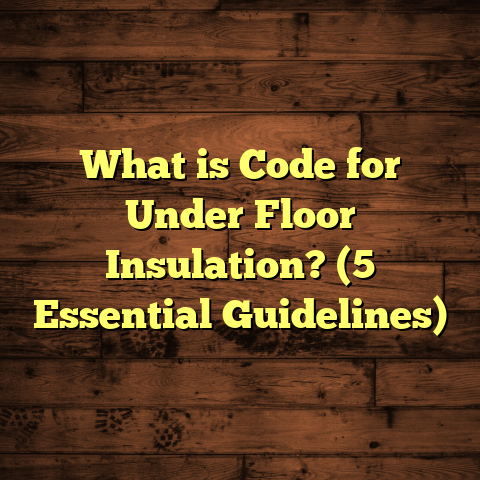What is a Significant Hardwood Floor Dip? (5 Signs You Need Repairs)
Accessibility is a big deal for me when I’m working with floors. Whether someone has mobility issues or just wants a home that feels safe underfoot, the state of hardwood floors matters a lot. I’ve seen many homes where a “significant hardwood floor dip” was overlooked for too long—and it changed everything from comfort to safety.
If you’ve ever felt like your hardwood floor isn’t quite level, or noticed a spot that seems to sink under your step, you might be dealing with this problem without even realizing it. Today, I want to share what I’ve learned about these dips—how to spot them, why they happen, and when it’s time to call in repairs.
What Is a Significant Hardwood Floor Dip?
Let’s start by really understanding what this means. A hardwood floor dip isn’t just a small scratch or dent. It’s an area where the floor surface noticeably sinks below the level of the surrounding boards. You might see it as a depression or feel it as an uneven spot when walking across the room.
This happens because the wood flooring or the subfloor beneath it has shifted. Sometimes moisture causes wood boards to swell and then shrink back, leaving gaps or low spots. Other times, the foundation or subfloor settles unevenly over time, causing parts of the floor to drop.
From my experience, these dips are often a sign of a bigger issue lurking under the surface. Fixing them early can stop damage from spreading and keep your home safe.
How I First Noticed These Dips
When I began working in flooring years ago, I didn’t pay much attention to small dips. I thought they were just part of natural wood movement. But on one project, I saw a dip near a doorway that was causing a door to stick badly. When I investigated, I found moisture damage in the subfloor below—a slow leak had been weakening the wood for months.
That was an eye-opener. Since then, I’ve made it a point to check for dips carefully and educate homeowners on why they shouldn’t ignore them.
Why Should You Care About Hardwood Floor Dips?
You might wonder if a dip is really worth worrying about. After all, floors aren’t perfectly flat all the time, right? True—but significant dips are more than just cosmetic flaws.
Here’s why you should care:
- Safety risks: Dips can create tripping hazards, especially for kids and seniors. A surface that’s uneven makes walking less predictable.
- Furniture stability: Tables, chairs, and shelves need a level base. A dip causes wobbling that can lead to damage or accidents.
- Damage progression: Dips often mean something has gone wrong with the structure below. If left alone, moisture or wood rot can spread.
- Home value: When potential buyers see uneven floors, they worry about hidden problems—and that can lower your home’s market price.
I’ve talked to homeowners who ignored these signs at first and ended up facing thousands in repairs later. That’s why catching dips early is so helpful.
5 Signs You Need Repairs for a Hardwood Floor Dip
Let’s talk about how you know when a dip needs fixing. Here are five clear signs I look for in my work—and that you can check yourself.
1. You Can Feel the Dip When Walking
One of the easiest ways to detect a dip is to walk barefoot over the area. If your foot sinks or rocks noticeably, that means the floor isn’t level.
I ask clients to do this simple test: walk slowly across the room and pay attention to any spots where your balance shifts or your step feels uneven.
In one home I worked on, the homeowner thought their floor was fine until they walked barefoot and felt an odd “give” near the center of the room. That led to discovering a large subfloor gap caused by settling.
2. Visual Gaps or Separation Between Boards
Look closely around the dip area. Do you see gaps between boards where they don’t line up? Are some boards lifting while others sink?
This usually means the wood has moved due to changes in moisture or foundation settling.
A client once told me they thought their floor was old and “naturally” splitting. When I inspected it closely, I found termite damage had weakened support beams underneath—causing those gaps.
3. Squeaking or Creaking Sounds
Have you noticed strange noises when walking near the dip? Squeaks often indicate loose boards or unstable subflooring.
I always listen carefully during inspections because noise can help pinpoint weak spots. Sometimes just tightening nails fixes squeaks, but other times it signals bigger problems like rotting wood.
4. Water Damage Signs Nearby
Discoloration, warping, or soft areas near the dip suggest moisture issues. Moisture is one of hardwood floors’ biggest enemies because it causes swelling, shrinking, and rot.
I use moisture meters regularly when inspecting dips. If levels exceed 12%, that’s a red flag for damage.
One memorable job was for a family whose dog often spilled water near a door. The repeated moisture caused warping and sinking in that area—turning into an expensive fix down the line.
5. Doors and Cabinets Don’t Close Properly
This might surprise you—but uneven floors can affect how doors and cabinets work. When floors dip, frames can shift slightly and cause doors to stick or fail to close fully.
A client once called me frustrated because their bedroom door wouldn’t shut after they noticed a dip near the doorway. Fixing the floor leveled things out and restored proper function.
What Causes Hardwood Floor Dips?
Understanding why dips happen can help you prevent them—or at least know what to look for.
Here are common causes I see over and over:
Subfloor Settling or Structural Movement
Homes settle naturally over time as soil compacts beneath foundations. This shifting can cause parts of the subfloor to drop unevenly.
Older homes—especially those built on pier-and-beam foundations—are more prone to this because of changes in soil moisture or poor initial installation.
Moisture Damage
Water is tough on hardwood floors. Leaks from pipes, spills, flooding, or high humidity cause wood fibers to swell and then shrink as they dry out, leading to warping and dips.
I always stress checking plumbing near kitchens, bathrooms, and laundry rooms when inspecting floors.
Poor Installation
Sometimes dips occur because floors weren’t installed correctly. If the subfloor wasn’t level before laying hardwood planks or if adhesives weren’t applied evenly, you might get uneven surfaces later.
When I started out, I saw many jobs where installers skipped important prep work—leading to problems years down the road.
Insect Infestation
Termites and carpenter ants weaken wood by eating through it. This damage can cause structural support under floors to fail and result in dips or sagging.
I’ve dealt with several cases where insect treatment was needed before any flooring repair could begin.
How I Inspect Hardwood Floors for Dips
Over time, I developed a thorough inspection routine that helps identify issues early:
- Visual Inspection: Look for discoloration, gaps, swelling, and dirt accumulation.
- Walk Test: Walk barefoot slowly over the floor to feel uneven spots.
- Straightedge Measurement: Use a straightedge or level tool to measure how deep dips are.
- Moisture Reading: Use a moisture meter on both wood surface and subfloor.
- Access Subfloor: If possible, inspect underfloor for cracks or rot.
- Check Doors/Cabinets: See if any hardware sticks or misaligns around dips.
This routine helps me provide clients with accurate diagnoses instead of guessing based on appearances alone.
Case Study: Fixing a Significant Dip in a Historic Home
A few years ago, I was called to repair floors in an old Victorian house with serious dips in several rooms. The homeowner wanted to preserve original hardwood but needed stability restored.
After inspection, I found:
- Subfloor joists were partially rotted due to decades of slow leaks.
- Some hardwood boards had warped beyond repair.
- Moisture levels were dangerously high near plumbing lines.
We had to:
- Replace damaged joists with pressure-treated lumber.
- Remove warped planks and source matching hardwood for replacement.
- Install a vapor barrier under flooring to control moisture.
- Refinish entire area for uniform appearance.
The project took three weeks but restored safety and beauty while preserving historic charm.
Practical Advice: Should You DIY Hardwood Floor Dip Repairs?
I get asked this question all the time: “Can I fix this myself?”
Here’s my honest take:
- For very minor dips (less than 1/8 inch), sanding or filling small gaps might be doable with right tools.
- But significant dips often need professional assessment because they involve subfloor repairs.
- Mistakes like improper leveling or ignoring moisture issues can lead to worse damage.
- Plus, lifting hardwood boards without breaking them requires skill and special tools.
If you’re not confident, calling a pro saves money long-term by avoiding botched repairs.
How FloorTally Has Helped Me with Cost Estimates
Estimating costs is one of the toughest parts of flooring projects because material prices, labor rates, and waste factors vary so much by location.
I started using FloorTally during larger projects because it lets me:
- Input local prices for hardwood types, underlayment, nails, adhesives.
- Add labor hours based on crew size and experience.
- Include waste factors (usually about 10%) for cutting scraps.
- See detailed breakdowns so clients understand where money goes.
- Make quick adjustments if scope changes mid-project.
It’s not perfect but saves me hours comparing quotes from suppliers. Plus clients appreciate transparent estimates upfront, which builds trust.
What Happens If You Ignore Hardwood Floor Dips?
I’ve seen it happen too often: homeowners think “it’s just cosmetic” and wait years before calling me out. Usually ends badly:
- Dip worsens as wood shifts more.
- Moisture spreads causing mold or rot.
- Furniture gets damaged from instability.
- Doors jam or frames bow.
- Repair costs balloon exponentially (sometimes 3x initial estimates).
A homeowner once told me they wished they’d called me sooner after spending $7K on emergency repairs instead of $1,500 early fixes.
Long-Term Maintenance Tips to Keep Floors Level
Prevention is always better than repair. Here are tips I share with clients:
- Control Humidity: Use dehumidifiers in damp seasons, humidifiers in dry winters.
- Quick Cleanup: Wipe spills immediately before water soaks in.
- Protective Pads: Attach felt pads under furniture legs.
- Regular Checks: Walk rooms slowly every few months looking for new dips or gaps.
- Plumbing Maintenance: Fix leaks promptly—don’t ignore drips near floors.
- Professional Inspections: Have pros check older floors every couple years especially if you notice noises or unevenness.
Materials Matter: Choosing Hardwood That Resists Warping
Not all hardwoods behave the same under humidity changes:
- Oak and Maple are popular but prone to expanding/shrinking.
- Hickory offers good hardness but can be tricky to install right.
- Engineered hardwood is more stable—it has layers that resist warping better than solid planks.
I always advise homeowners in humid climates to consider engineered options if budget allows—they tend to hold up better around moisture-prone areas.
Personal Stories From My Work: Memorable Floor Dip Fixes
Every job teaches me something new—here are some stories:
- A family in Florida had severe dips after hurricane flooding; we had to replace entire subfloor plus install waterproof barriers.
- A couple renovating their first home found termite damage under their beautiful old pine floors; we treated infestation before repairs.
- An elderly client was grateful we caught early dips before they caused falls; we leveled flooring quickly making her home safe again.
These experiences remind me how important it is not to ignore signs—even small ones—of floor damage.
Frequently Asked Questions About Hardwood Floor Dips
Q: Can hardwood floors fix themselves over time?
A: No—they don’t “heal.” Wood responds to environment but won’t return to flat by itself once dipped significantly.
Q: How deep is too deep for a dip?
A: Anything over 1/4 inch usually needs professional intervention; minor dips under 1/8 inch might be fixable with sanding or fillers.
Q: How long do repairs take?
A: Depends on extent—from a day for small sanding jobs up to weeks if subfloor replacement needed.
Q: Can new hardwood go over old damaged floors?
A: Sometimes—but often old damage affects stability; best practice is removing compromised materials first.
Final Thoughts
I hope this gives you a clear picture of what significant hardwood floor dips are, why they happen, how you spot them early, and what steps you can take next.
Floors are more than just decoration—they’re something we rely on every day, so keeping them even and sturdy is worth it.
If you notice unevenness in your hardwood floors or hear creaks when walking, don’t wait until it gets worse. Reach out for an inspection—it could save you time, money, and headaches down the road.
Feel free to reach out anytime if you want advice based on my hands-on experience or want help estimating costs using tools like FloorTally—it’s made my job easier and could help with your project too!
Have you experienced dips in your floors? What did you do? Let’s chat—I’m here to help!





